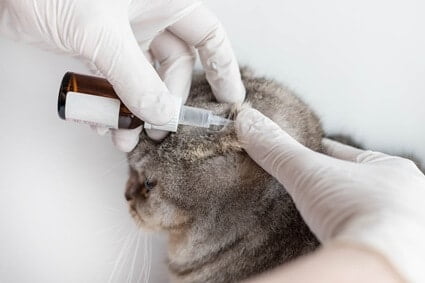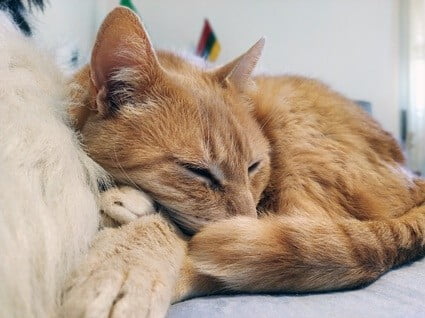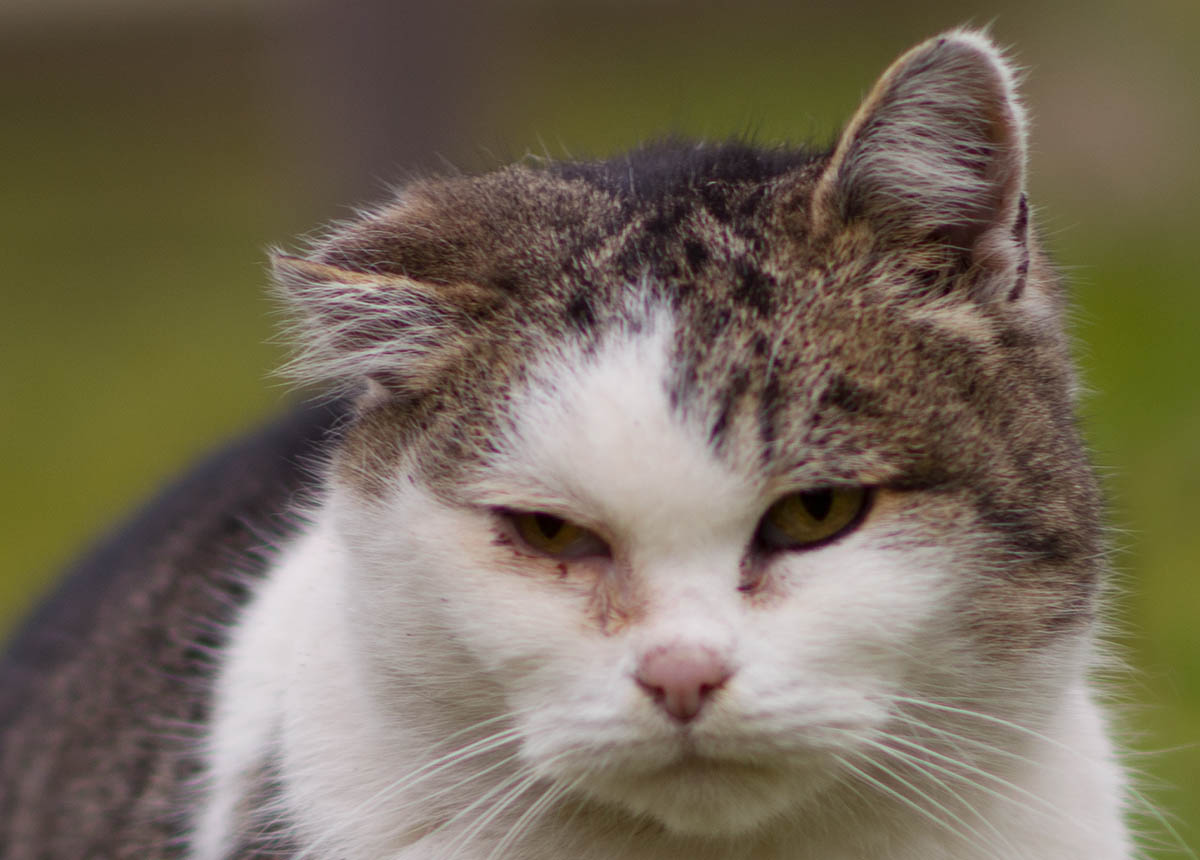A cat’s ears are one of its most expressive body parts. They may perk up, swivel around, or lie flat to show a cat’s mood. However, the most common thing you’ll see is a cat’s ears twitching back and forth. This is a reflexive action in most cases because felines have more control over their ears than humans. While this action is sometimes involuntary, cats often twitch their ears to hear more clearly.
If your cat’s ears twitch, it may be feeling excited to see you, investigating a toy, or trying to identify the location of prey. Cats can hear sounds 1.6 octaves above humans. This is done by angling their ears to capture the most sound, getting a precise reading. Cats will twitch their ears if they detect a small movement or hear a faint noise. Even if an object doesn’t make a sound, cats naturally twitch their ears to learn more.
Cats twitch their ears several times a day by default. If it happens several times a minute or hour, though, it’s a more worrying sign. This is because your cat may have an ear infection, mites, lice, fleas, or growths on its ears. Cats then twitch their ears to try and shake off the discomfort.
What Does It Mean When A Cat’s Ear Twitches?
Because cats have more control over their ears than humans, it’s perfectly natural for them to twitch now and then. This behavior plays into a cat’s:
- Body language
- Ability to hunt
- Ability to understand its environment
Because of that, you can learn what your cat is thinking, seeing, or hearing by watching its ears. A small twitch can even mean it’s happy to see you.
However, there are times when a cat twitches its ears far too often. If this happens multiple times an hour when your cat isn’t exposed to strange new sounds, it could mean it’s dealing with a medical issue.
Spotted Prey
Cats rely on their impressive hearing to stalk prey. Because of the shape of their ears, cats are able to hone or tune into more specific sounds. This is done by twitching their ears or even rotating them at an angle.
This catches vibrations and funnels them into the ear canal. The motion will also allow the sides and back of a cat’s ears to block out other sounds that don’t matter. With this level of precision, cats will pinpoint:
- A specific noise
- Its location
- Better understand what it means
As an example, your cat may twitch its ears when it detects the tiny footsteps of a mouse. It will then rotate its ears if it can’t get a strong reading on what the sound is and where it’s coming from. By alternating the position of the ears, the cat will detect more sounds.
Once it gets the clearest reading on the noise in question, it will focus its ears in that direction. It can then react based on the new information this presents. For instance, the mouse could be on the left side of the room, under a table, and moving very slowly to avoid detection. A little bit of ear twitching proved this was the case.
This habit is engrained in a cat’s natural instincts. Because of that, cats may twitch their ears when investigating anything, even if it doesn’t make noise. If your kitty has taken an interest in a toy, it may rotate its ears as it approaches the object to better understand it.
Excited To See You
Twitching can also be a sign of affection. If a cat is happy to see you, it will rotate its ears to be sure of:
- Where you are
- What sounds you’re making
- What you’re doing
That’s because cats use their superior hearing to better understand their environment. If they twitch their ears frequently, then it means they want to know more about a subject. One twitch should tell the cat that you’re home, and that’s that. If it keeps twitching its ears, then it’s interested in knowing more about you.
How are you? What do you sound like? Do you sound healthy and normal? Do you have something with you? The added interest proves that your cat values your presence; you’re not just another creature passing through.
Shaking Off An Itch
Have you ever felt an itch on your leg, but couldn’t find a reason? Sometimes twitching your leg is all it takes to shake it off. Cats do the same thing with their ears.
Your kitty may have detected a bug fluttering near its ear, felt a hair lay wrong and become irritating, or wanted to test a muscle that felt a little too tight. By twitching its ear in a quick motion, it got rid of the discomfort and felt better.

Mite Infestation
Ear twitching isn’t always a normal occurrence. If a cat is dealing with a mite infestation, it will twitch and flick its ears semi-constantly. This is an effort to shake away the irritation like it would with flies or gnats. Since mites hang on tight, the cat has no choice but to flick its ears several times a minute, hour, and day to no avail.
Cats are very skilled groomers, but they can still fall victim to these annoying bugs. That’s particularly true if your cat likes hanging out in the yard. If your pet seems to be twitching its ears to remove something, take a closer look.
Medical Issue
Aside from bugs, cat ears may get irritated by other factors. They will cause the feline to twitch its ears constantly to find relief. The usual culprits are:
- Bacterial infections
- Inflammation of the ear canal
- Ear diseases like otitis externa
These illnesses can make the cat’s ears burn, itch, and ache. Your feline may scratch at the ears, rub them against flat surfaces, or twitch them frequently to stop the discomfort. When that doesn’t work, the cat may become aggravated and moody. It can even begin damaging its own ears through excessive scratching.
Is It Normal For A Cat’s Ear To Twitch?
Ear twitching in cats is usually a reflex action. It’s no different than the way your eyes might dart toward a strange noise or movement from the corner of your eye. Because of that, you shouldn’t worry if your cat appears to twitch its ears for no reason. It’s natural behavior if:
- Someone has entered the room
- A noise was made outside, such as by a car driving past
- Another pet has lifted its head or moved around
- You’ve brushed against an object, making a gentle whisper
The cat is merely tuning into the sounds around it and trying to understand them. If the sounds are normal and not worth investigating, the cat will not twitch or rotate its ears any further. If the sound is unfamiliar or inconsistent, the cat may twitch its ears more to get a solid understanding of the noise.
This is also true if the cat has spotted a small movement, but doesn’t want to stand up, draw closer, or give away its own position. If you’ve nudged a toy as you walked by, for example, the cat may twitch its ears as it watches the object move and settle.
Even if you don’t notice the sound or movement, your cat might. Cats are able to detect sounds that are 1 octave above canines, and 1.6 octaves above humans. This means a bug scurrying across a wall or a distant car horn may catch your feline’s attention. Its ears will twitch to hone in on a noise you can’t even hear.
Why Does My Cat’s Ear Twitch When I Touch It?
Your cat’s ears may twitch automatically when you touch them. That’s because cats have over 30 ear muscles that are extremely sensitive to touch. Even if the pressure isn’t uncomfortable, the cat will naturally shift its ears around to dispel the sensitive feeling.
The hair around your cat’s ears is also delicate. Even a gentle breeze will disturb this soft hair and translate the vibrations to the muscles underneath. This will make your cat feel ticklish, encouraging it to move away or just twitch its ears a few times to shake out the feeling.
Of course, that doesn’t mean you should avoid petting this spot. So long as the cat doesn’t move out of your reach, a few gentle scritches can feel nice. Just give your kitty room to twitch, so that the tickling sensation doesn’t become uncomfortable.
Cat’s Ears Twitching While Sleeping
A cat’s ears may also twitch when it’s sleeping. Like humans, cats are able to dream. They will move around gently in response to what they see. This may include shifting their paws, squinting their eyes, and twitching their ears.
According to the University of Chicago, this is a result of low voltage electroencephalogram patterns. Younger cats and kittens also tend to twitch more than older cats. That’s because they spend most of their time sleeping as a way to grow and develop. Twitching the muscles around their ears and body helps in the development of their nervous system.
That’s combined with Rapid Eye Movement (or REM), which occurs in the deepest stage of sleep. REM is an experience that many animals go through while resting, and it’s usually characterized by bodily movements. As such, if your cat twitches its ears while it sleeps, it’s resting very deeply.
However, cats have a unique advantage with these little movements. By twitching their ears, they are sending a warning sign to others around them that they are awake and conscious of their surroundings. This can discourage other cats or small predators from trying to sneak up on a sleeping cat. They can’t be sure the feline’s guard is actually down, after all.
Cat Has One Ear Twitching
Ear twitching is a form of body language. Other than showing affection, it can also express if a cat is anxious or upset. You’ll notice this when a cat only twitches one ear. It’s not trying to tune into any particular sound or it would use both ears.
Instead, its attention is divided and it’s concerned about something it can’t pinpoint. This can happen when cats are emotionally distressed, sometimes by other pets, their environment, or even the food they’re provided. Mites rarely attack one ear, so it is rare for your cat to twitch a single ear because of an infestation.
Excessive Ear Twitching in Cats
While ear twitching is usually normal, it can become abnormal when it’s constant. Your cat should not twitch its ears every few seconds or minutes.
Even in a strange new environment or when bombarded with sounds, cats do not just flick their ears constantly. They also display signs of fear or distress. If your cat is otherwise docile and calm, but its ears keep twitching back and forth, you’re dealing with a medical issue. It can be a result of irritation or inflammation, usually caused by:
- Mite or flea infestations
- Ear infections
- Non-cancerous growths in the ear
- Bacterial diseases
What Causes Ear Twitching In Cats?
There are ways to tell if your cat is twitching its ears for the wrong reasons. To spot illnesses and infections early, look for specific signs:
Cat’s Ears Twitching And Shaking Head
If your cat’s ears are twitching and it shakes its head repeatedly, it may be struggling with parasites or mites. The cat is trying to shake away the discomfort. It will also begin rubbing and scratching at the affected ear with its paws. If it could dislodge the bugs, it thinks, that irritation would go away.
Sadly, mites, lice, and fleas can be microscopic. Your cat has no chance of removing the discomfort without your intervention. Without proper treatment, the infestation will spread to other parts of your cat. This could result in:
- Hair loss
- Irritability
- Excessive scratching
You can help your cat find relief by taking it to the vet or by using topical treatments for fleas and ear mites. This can be found over-the-counter at many general stores or pharmacies.

Cat Keeps Shaking Head But No Mites
Ear infections are rare in cats, but they do happen. Most owners detect them once they’ve investigated for mites and came up short.
For cats, infections normally develop inside the ear canal, rather than on the exterior part of the ear. An inner ear infection will cause your pet to twitch its ears and shake its head repeatedly. The illness may even throw off your cat’s balance and cause it to:
- Wobble in place
- Miss jumps
- Walk unsteadily
- Refuse to walk unless necessary
In severe cases, the infected ear may release a foul smell or discharge. This is usually caused by otitis externa, a condition that results in pain and discomfort. The affected ear will become red and inflamed. The persistent distress will force your cat to shake its head vigorously in an attempt to remove the fluids and debris from its ear.
Your cat may also shake its head if it has polyps (non-cancerous growths) inside its ears. Even though these pinkish growths are benign, they can be really irritating to a cat. They can even lead to middle ear infections, which may be the first red flag you notice.
Taking your cat to the vet can help diagnose any issues correctly. A professional can recommend an effective treatment for your cat.
Cat’s Ear Twitching After Flea Medication
If your cat’s ear is twitching after flea medication, it’s probably because of an allergic reaction caused by the product. Some flea treatments are highly toxic and can harm your pet soon after application. If you notice excess salivation and muscle tremors, this is definitely the case.
These symptoms usually subside on their own. However, if they persist, you should give your cat a warm bath using mild hand soap. You can also dry your cat with a warm towel and brush to get rid of the symptoms.
Ear twitching is normal behavior for cats. It indicates that your feline has detected a strange noise, is happy to see you or is trying to stalk prey. If you notice the twitching happens too often, then look for a mite infestation or infection.

